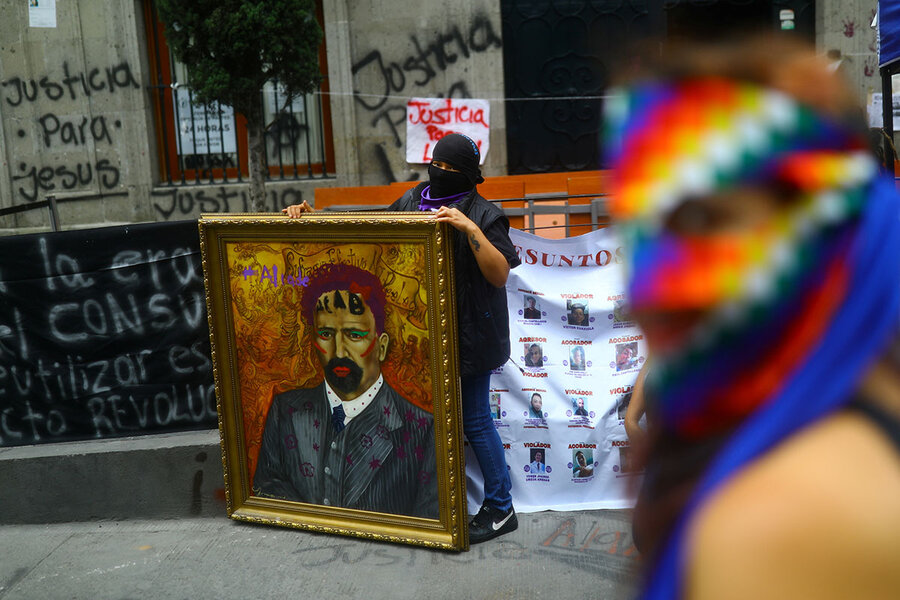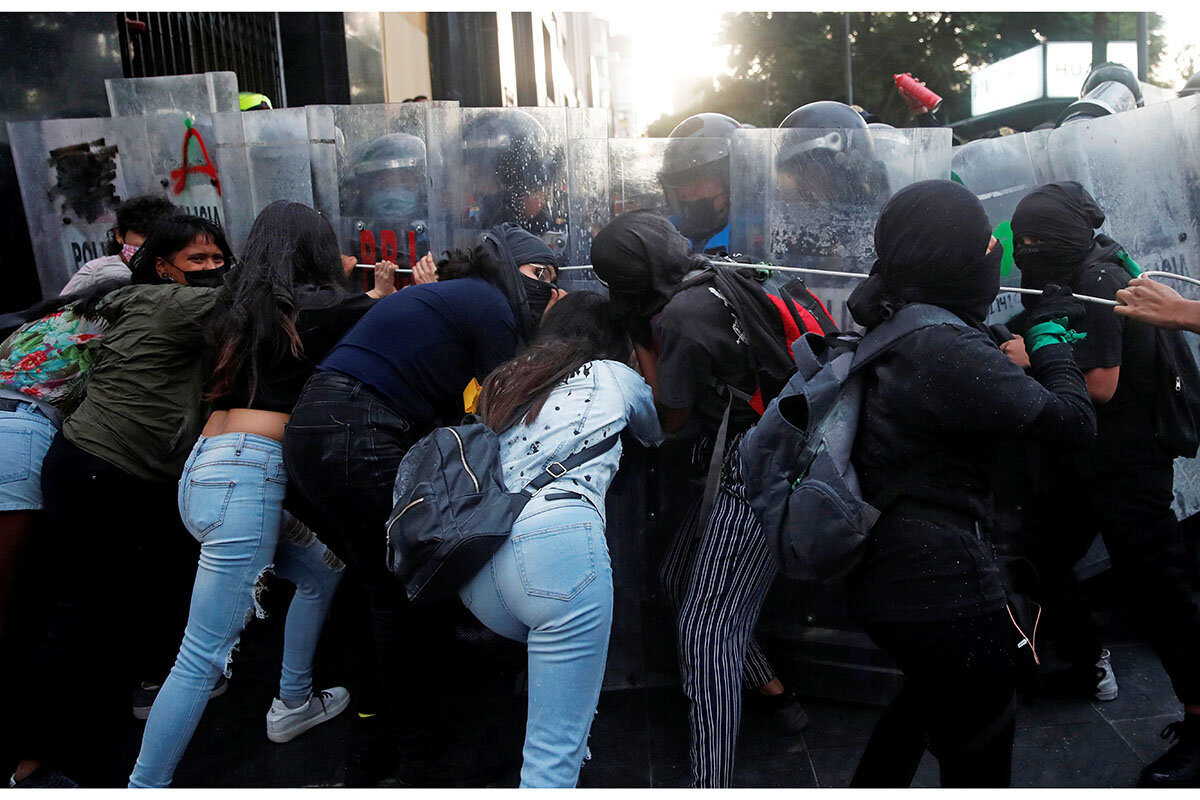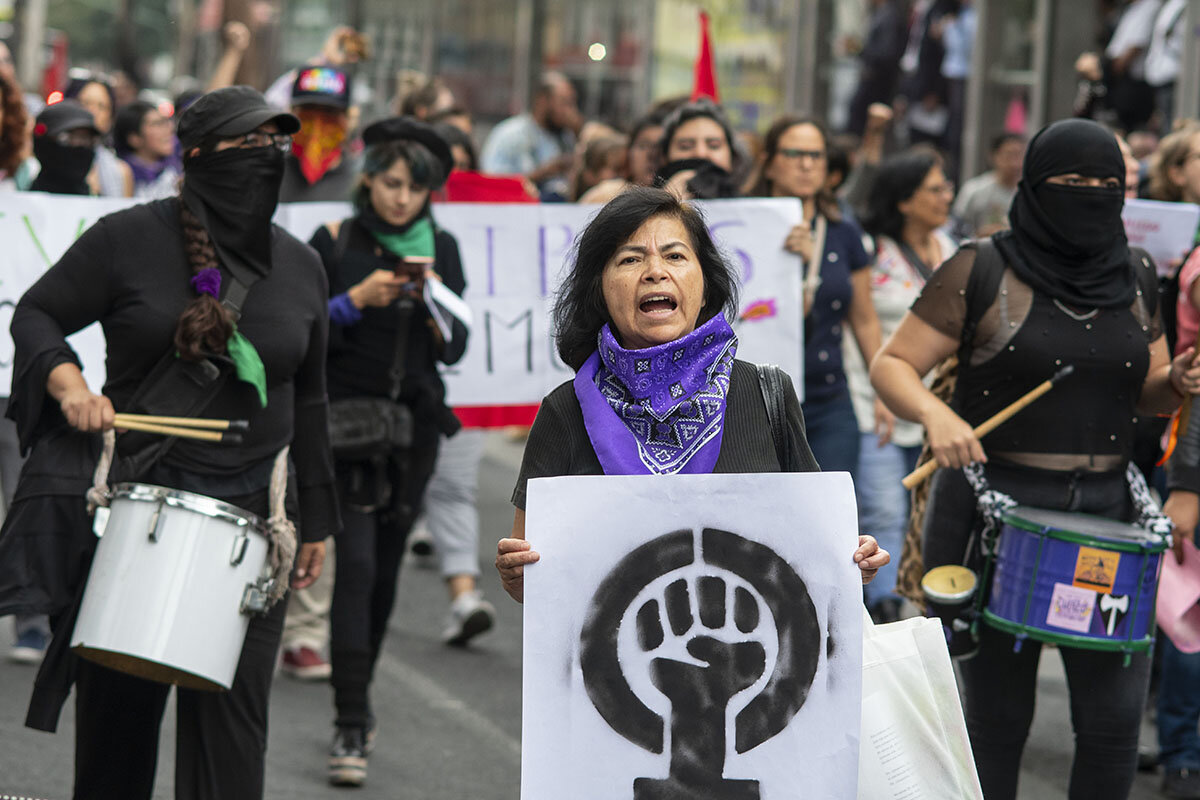Mexico's feminist protests grow louder. So does debate over tactics.
Loading...
| Mexico City
Femicides have doubled over the past five years in Mexico. And feminists, frustrated after years of demands for better protections and justice, are making their protests increasingly vocal and visible: “glitter protests,” for example, launched by covering the capital’s police chief with pink glitter; or a national women’s strike last spring.
And since September, a group of feminists has taken over the National Commission for Human Rights’ offices in Mexico City, building on years of mounting outrage. Portraits of historical figures were turned upside down or repainted; walls were covered with feminist slogans. The building was converted into a women’s shelter, with some 40 women and children currently living there, and demonstrators are collecting supplies for victims.
Why We Wrote This
What’s the right way to spark reform – especially when change has been frustrated time and again? That question has been top of mind amid global protests for racial justice and against gender-based violence.
Attention to their cause is increasingly focused on whether the more radical tactics are the “right” way to fight for change, and about what makes a “real” feminist. Spray-painting a monument or clashing with police may be common in protests worldwide, but it’s seen as especially contentious when carried out by women, says Daniela Cerva, a Mexican sociologist.
“Women aren’t allowed to express anger. Crying is what’s expected from us,” she says. “But direct confrontation, or taking over a [building]?”
“No. Women are meant to be quiet in the public space.”
Scrawled on a formerly white wall inside the National Commission for Human Rights (CNDH) offices in Mexico City is the image of a woman in a purple dress leaning over the spitting flames of an orange and red fire. A number of conversation bubbles surround the painting, but only one is colored in to make the words pop:
“To build,” it reads, “you have to destroy.”
The phrase was painted by a group of feminists who gained international attention this fall when they took over the government building, demanding better protection for women and girls in Mexico. Groups of mothers, victims, and activists took over a handful of human rights offices across the country in September, building on years of mounting outrage. But attention to their cause is increasingly focused on whether the women are fighting for change the “right” way – echoing rhetoric that has swirled around racial justice protests in the United States, as well as other feminist movements around the world in recent years.
Why We Wrote This
What’s the right way to spark reform – especially when change has been frustrated time and again? That question has been top of mind amid global protests for racial justice and against gender-based violence.
In Mexico City, site of the first occupation, government workers were kicked out of the CNDH building two days after the mother of a young rape victim tied herself to a chair to protest inaction around her daughter’s case. Portraits of historical figures were turned upside down or given new looks via the addition of green eyeshadow or devil horns. Walls were painted over with feminist slogans, like “not one less” and “we want them alive.” The building was converted into a women’s shelter, with some 40 women and children currently living there.
The CNDH protests are the latest in a series of increasingly loud calls for the government to better protect women in a nation where femicides have doubled during the past five years. An estimated 10 women are murdered each day in Mexico, according to state statistics. With university students protesting sexual assault at the hands of faculty members, so-called glitter protests launched by covering the capital’s security chief with pink glitter, the historic turnout for Women’s Day marches last spring, and a national women’s strike the following day, momentum has grown here in recent years.
But Mexicans across social media – and the president – are questioning protest strategies, asking how taking over buildings and painting over portraits are necessary to guarantee safety for women. The more radical approach to calling attention to violence against women has sparked debates over what makes a “real” feminist, and has some arguing that it distracts from the broader goal of a more peaceful, safer nation for women.
“The indignation is the same; what’s changing are the strategies,” says Daniela Cerva, a sociologist at the Autonomous University of Morelos State, who studies feminist movements in Mexican universities. “Before women sat and asked for a meeting, or went out with their signs and sang or yelled.” Now, they’re taking over buildings, carrying out art interventions, or choreographing mass performance pieces.
Although spray-painting a monument and clashing with police may be common in protests worldwide, they are seen as especially contentious when carried out by women, Dr. Cerva says. “Women aren’t allowed to express anger. Crying is what’s expected from us. But direct confrontation, or taking over a [building]?” she asks.
“No. Women are meant to be quiet in the public space.”
Art critics
Many Mexicans hoped President Andrés Manuel López Obrador’s 2018 election would spell a new frontier for the protection of human rights. He ran on a platform of defending poor people, and undoing years of political corruption. But for many feminists, he’s disappointed. He’s blamed predecessors’ neoliberal policies for high rates of femicides, cut funding for the National Women’s Institute, and shuttered shelters for victims of domestic violence. The administration has proposed supporting victims with direct payments, but women’s advocates have questioned the plan’s effectiveness.
AMLO, as the president is known, expressed sympathy for the activists who took over the CNDH offices in Mexico City last month. Yet he made it clear he didn’t approve of their tactics, calling their approach “the wrong way.”
The protest art painted on banners inside the CNDH building, and over portraits of historical figures like Benito Juárez, has gained particular attention.
“Whoever knows the story of this social warrior would know that we should have respect for him,” AMLO said during a daily press conference, in reference to a painting of Francisco Madero, a former president whose portrait was revamped with purple hair and a cherry-red pucker. “You can’t fight violence with violence.”
That didn’t sit well with Erika Martinez, a mother who was part of the initial takeover – and whose daughter repainted Mr. Madero. Her daughter was sexually abused three years ago when she was 7 years old, and the case is still dragging on, with the accused walking free. Ninety-three percent of crimes in Mexico are not reported or not investigated, and the impunity rate for gender violence is believed to be even higher.
“I want to know how the president is outraged about the painting,” Ms. Martinez shouted, holding back tears last month, speaking in front of the occupied building. “Why isn’t he outraged about the abuse of my daughter?”
Protesters say they want to see gender sensitivity training for police, broader abortion rights, crimes prosecuted, laws enforced, and for the president to recognize the legitimacy of their demands. In the meantime, they have no plans to leave the building, and are collecting clothes, school supplies, and food for victims.
The CNDH announced last month there would be no retaliation taken against the protesters, and that they would urge federal and state officials to “refrain from issuing statements that minimize the serious situation of violence experienced by girls, young people, and women throughout the national territory.”
Ends, not means?
Anai Flores Olarte sits in her home in the coastal state of Veracruz on a recent afternoon, chickens clucking in the background. The 22-year-old single mother says she identifies as a feminist, although she’s never participated in a large protest. But she doesn’t agree with vandalism as a form of protest.
“It makes me sad to see women damaging these buildings, kicking out the people who work there and might be able to help them,” she says by phone. “I support that they are there, and why they are there, but not how they are doing it.”
Ms. Olarte posted in a Facebook group dedicated to raising awareness about femicides last month, questioning the need for destruction when what Mexico needs is to focus on “how to support each other, how to get more involved in politics.” The vast majority of commenters disagreed, but a handful had her back, asking why the buildings themselves should be a target.
Dr. Cerva says she’s hearing nuanced responses like Ms. Olarte’s more and more among Mexican women. Even when there is disagreement over tactics, they often say, “‘I understand why she’s breaking things. I wouldn’t do it. I might not agree with it. But I understand it.’”
Some observers see irony in the dismissal of feminists taking over buildings or public spaces. The president used the same tactic himself.
After AMLO’s first failed run for president, in 2006, he contested the loss by taking over blocks of a major thoroughfare and plaza in downtown Mexico City, blocking traffic, forcing businesses to close, and proclaiming himself the winner. There were also complaints when protesters shut down highways after the disappearance of 43 aspiring teachers in 2014.
“This grumbling around the seizure of property has always existed, but with the feminists [taking over CNDH offices] it feels so much more extreme,” says Fernanda Guerra, host of the current events podcast “Sin Comentarios MX.” In her view, that criticism ignores that protest “is a consequence of a system that has truly failed a lot of women. They’ve asked to be heard so many times and in so many ways and yet they’re still not protected.”
This is what Dr. Cerva calls “double victimization,” when reports of abuse are ignored or blundered. In many cases, women aren’t calling for new laws, she points out, but the enforcement of what the government has already committed to on paper.
“To be a woman in Mexico,” she says, “is a political act.”










